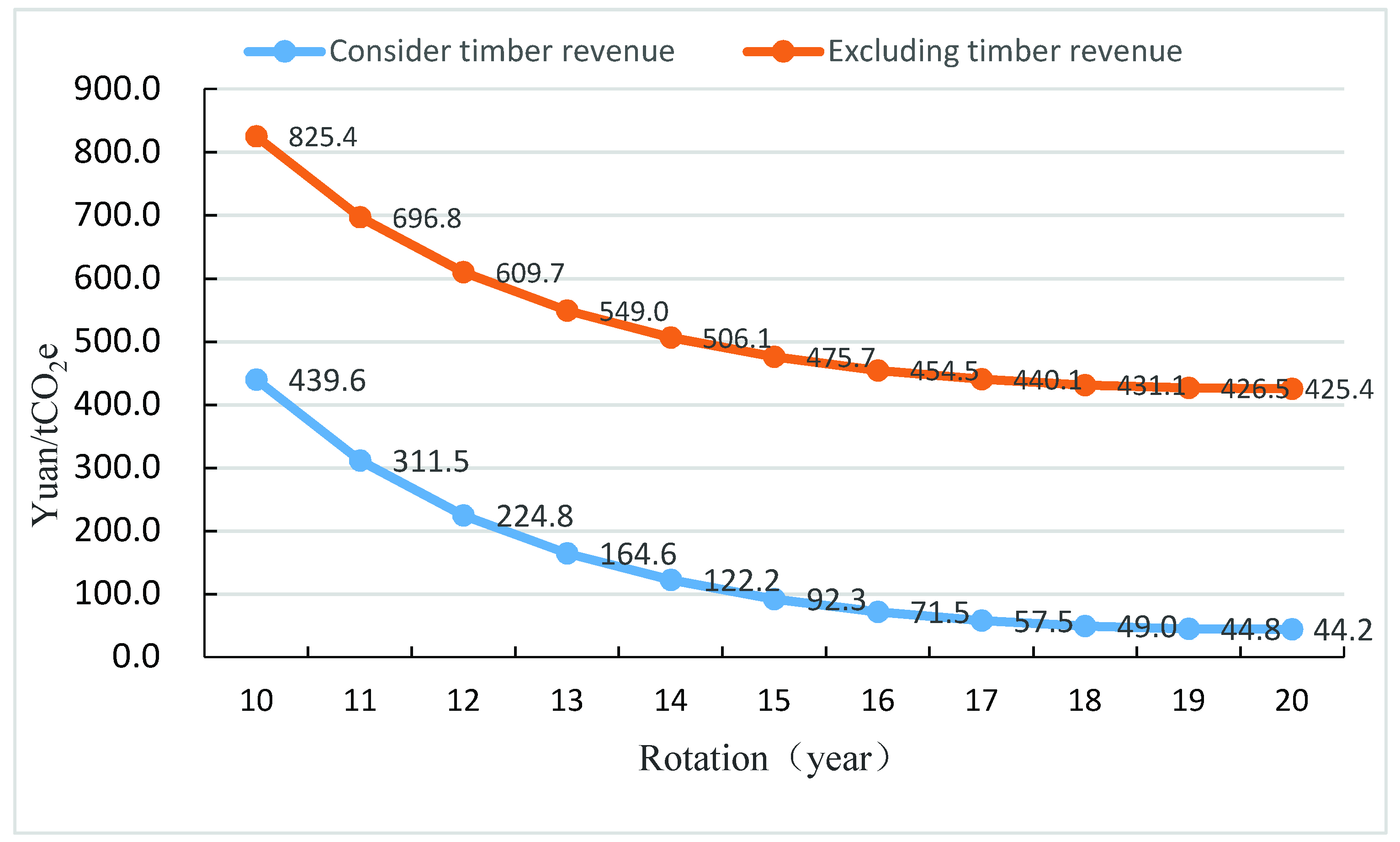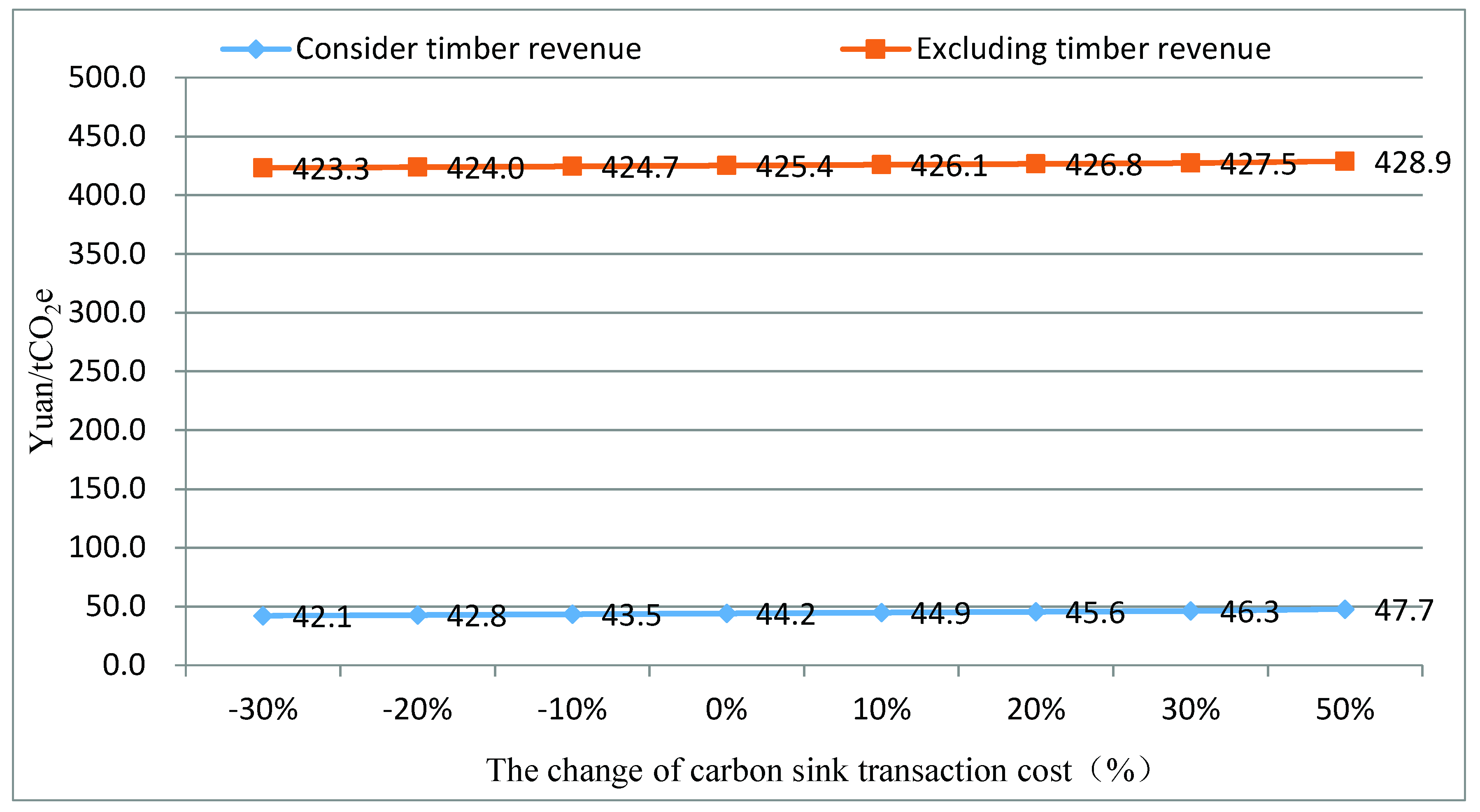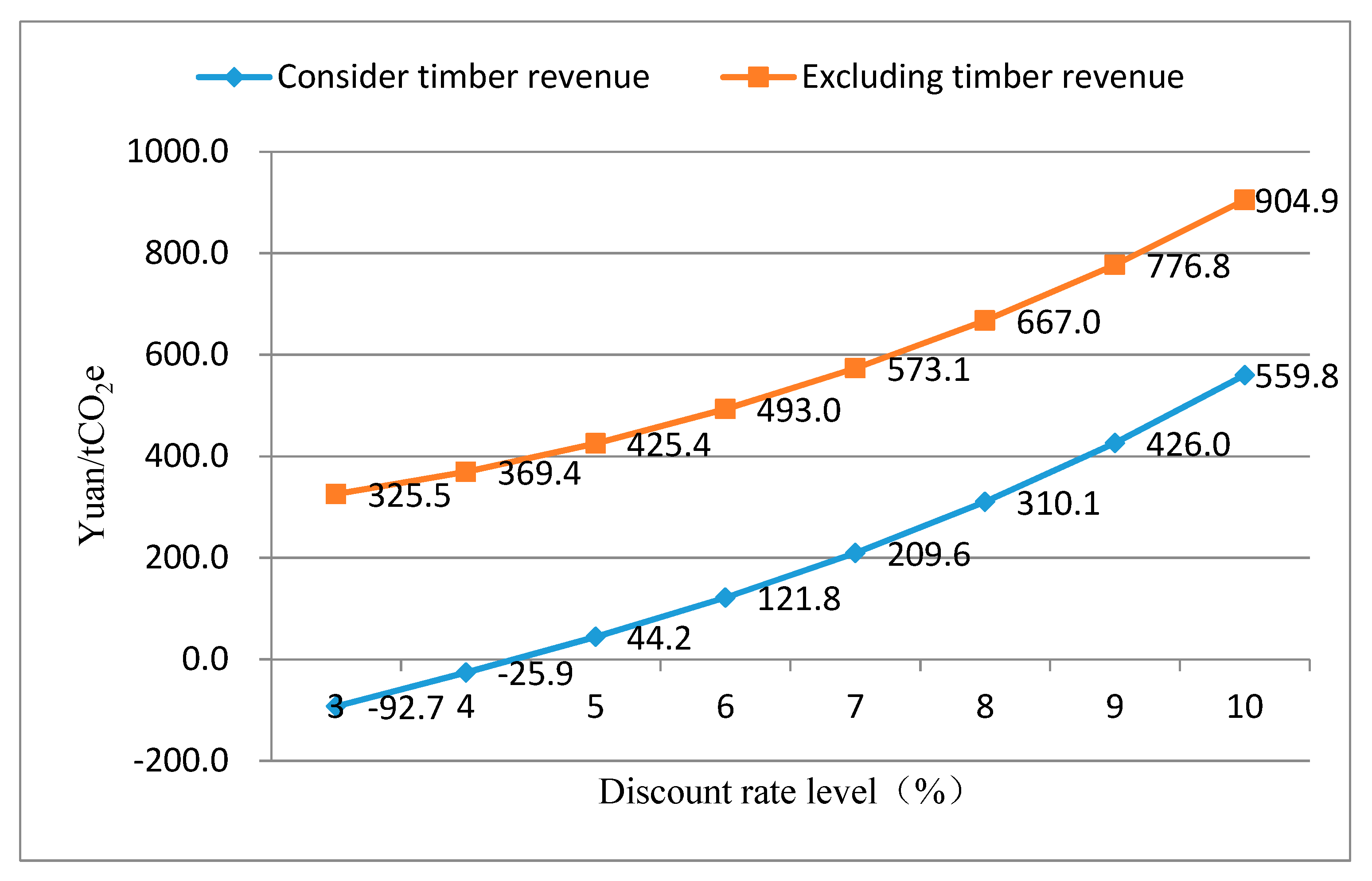Quantifying the Carbon Sequestration Costs for Pinus elliottii Afforestation Project of China Greenhouse Gases Voluntary Emission Reduction Program: A Case Study in Jiangxi Province
Abstract
:1. Introduction
2. Materials and Methods
2.1. Model Selection
2.1.1. Woodland Net Present Value Model
2.1.2. Carbon Sink Accounting Model in a Rotation Period
2.1.3. Land Opportunity Cost Accounting Model
2.1.4. Carbon Sink Cost Measurement Model
2.2. Data Sources
2.2.1. Afforestation Cost
2.2.2. Land Rent
2.2.3. Carbon Sequestration Transaction Cost
3. Results
3.1. The Carbon Sequestration Cost of the P. elliottii Afforestation Project in Different Rotation Periods
- (1)
- During the project operation, as the rotation period increases, the carbon sequestration costs of the P. elliottii afforestation project showed a downward trend. When the value of wood is considered, the costs reach the lowest at the best rotation of the 20th year, and the carbon sink costs is 44.2 yuan/tCO2e. When the value of timber is not considered, the carbon sequestration costs decreased from 825.4 yuan/tCO2e in the 10th year to 425.4 yuan/tCO2e in the 20th year, a decrease of 48.4%.
- (2)
- The effect of wood income on overall carbon sequestration costs is very significant. To be specific, carbon sequestration costs were 44.2 tCO2e in the 20th year when the timber benefits are considered, while the costs was as high as 425.4 yuan/tCO2e when the timber benefits is not considered, which is 8.62 times higher than the former. This demonstrates the substantial negative impact of wood income on carbon sequestration costs. This also implies that carbon sink costs may be lower if multiple benefits of the afforestation project are considered.
3.2. Sensitivity Analysis of Carbon Sink Costs under Different Conditions
3.2.1. The Sensitivity of Carbon Sink Costs to Changes of Carbon Sink Transaction Costs
3.2.2. The Sensitivity of Carbon Sink Costs to Changes of Labor Prices
3.2.3. The Sensitivity of Carbon Sink Costs to Changes of Discount Rates
3.2.4. The Sensitivity of Carbon Sink Costs to Changes of Timber Prices
4. Discussion
5. Conclusions
Author Contributions
Funding
Conflicts of Interest
References
- Friedlingstein, P.; Andrew, R.M.; Rogelj, J.; Peters, G.P.; Canadell, J.G.; Knutti, R.; Luderer, G.; Raupach, M.R.; Schaeffer, M.; Van Vuuren, D.P.; et al. Persistent growth of CO2 emissions and implications for reaching climate targets. Nat. Geosci. 2014, 7, 709–715. [Google Scholar] [CrossRef]
- Elzen, M.D.; Fekete, H.; Höhne, N.; Admiraal, A.; Forsell, N.; Hof, A.F.; Olivier, J.G.J.; Roelfsema, M.; Soest, H.V. Greenhouse gas emissions from current and enhanced policies of China until 2030: Can emissions peak before 2030? Energy Policy 2016, 89, 224–236. [Google Scholar] [CrossRef] [Green Version]
- IPCC. Climate Change 2014: Mitigation of Climate Change; Cambridge University Press: Cambridge, UK, 2014. [Google Scholar]
- WMO. The Global Climate by 2015–2019; WMO Report; World Meteorological Organization: Geneva, Switzerland, 2019; pp. 1–50. [Google Scholar]
- Ambardekar, A.A.; Siebenmorgen, T.J.; Counce, P.A.; Lanning, S.B.; Mauromoustakos, A. Impact of field-scale nighttime air temperatures during kernel development on rice milling quality. Field Crop. Res. 2011, 122, 179–185. [Google Scholar] [CrossRef]
- Hartfield, G.; Blunden, J.; Arndt, D.S. State of the Climate in 2017. Bull. Am. Meteor. Soc. 2018, 99, S1–S310. [Google Scholar] [CrossRef]
- Canadell, J.G.; Raupach, M.R. Managing forests for climate change mitigation. Science 2008, 320, 1456–1457. [Google Scholar] [CrossRef] [PubMed] [Green Version]
- Dixon, R.K.; Solomon, A.M.; Brown, S.; Houghton, R.A.; Trexier, M.C.; Wisniewski, J. Carbon Pools and Flux of Global Forest Ecosystems. Science 1994, 263, 185–190. [Google Scholar] [CrossRef]
- Bastin, J.F.; Finegold, Y.; Garcia, C.; Mollicone, D.; Rezende, M.; Routh, D.; Zohner, C.M.; Crowther, T.W. The global tree restoration potential. Science 2019, 365, 76–79. [Google Scholar] [CrossRef]
- Pan, Y.; Birdsey, R.A.; Fang, J.; Houghton, R.; Kauppi, P.E.; Kurz, W.A.; Phillips, O.L.; Shvidenko, A.; Lewis, S.L.; Canadell, J.G.; et al. A large and persistent carbon sink in the world’s forests. Science 2011, 333, 988–993. [Google Scholar] [CrossRef] [Green Version]
- Van Kooten, G.C.; Binkley, C.S.; Delcourt, G. Effect of carbon taxes and subsidies on optimal forest rotation age and supply of carbon services. Am. J. Agric. Econ. 1995, 77, 365–374. [Google Scholar] [CrossRef] [Green Version]
- Benítez, P.; Mccallum, I.; Obersteiner, M.; Yamagata, Y. Global Supply for Carbon Sequestration: Identifying Least-Cost Afforestation Sites under Country Risk Consideration; IR-04-022; IIASA: Laxenburg, Austria, 2004. [Google Scholar]
- Pandey, R.; Hom, S.K.; Harrison, S.; Yadav, V.K. Mitigation potential of important farm and forest trees: A potentiality for clean development mechanism afforestation reforestation (CDM A R) project and reducing emissions from deforestation and degradation, along with conservation and enhancement of carbon stocks (REDD+). Mitig. Adapt. Strateg. Glob. Chang. 2016, 21, 225–232. [Google Scholar] [CrossRef]
- Zhou, W.; Gong, P.; Gao, L. A Review of Carbon Forest Development in China. Forests 2017, 8, 295. [Google Scholar] [CrossRef] [Green Version]
- Lo, A.Y.; Ren, C. After CDM: Domestic carbon offsetting in China. J. Clean. Prod. 2017, 141, 1391–1399. [Google Scholar] [CrossRef] [Green Version]
- Massetti, E.; Tavoni, M. A developing asia emission trading scheme (Asia ETS). Energ. Econ. 2012, 34, S436–S443. [Google Scholar] [CrossRef] [Green Version]
- Li, W.; Jia, Z. Carbon tax, emission trading, or the mixed policy: Which is the most effective strategy for climate change mitigation in China? Mitig. Adapt. Strateg. Glob. Chang. 2017, 22, 1–20. [Google Scholar] [CrossRef]
- Huang, Z.S.; Chen, Q. Influencing factors analysis of forestry carbon sequestration cost-benefit based on afforestation cost methods. Resour. Sci. 2016, 38, 485–492. (In Chinese) [Google Scholar]
- Ndjondo, M.; Gourlet-Fleury, S.; Manlay, R.J.; Engone Obiang, N.L.; Ngomanda, A.; Romero, C.; Claeys, F.; Picard, N. Opportunity costs of carbon sequestration in a forest concession in central Africa. Carbon Bal. Manag. 2014, 9, 4. [Google Scholar] [CrossRef] [Green Version]
- Kooten, G.C.V.; Sabina, L.S.; Pavel, S. Mitigating climate change by planting trees: The transaction costs trap. Land Econ. 2002, 78, 559–572. [Google Scholar] [CrossRef]
- Galik, C.S.; Cooley, D.M.; Baker, J.S. Analysis of the production and transaction costs of forest carbon offset projects in the USA. J. Environ. Manag. 2012, 112, 128–136. [Google Scholar] [CrossRef]
- Pearson, T.R.H.; Brown, S.; Sohngen, B.; Henman, J.; Ohrel, S. Transaction costs for carbon sequestration projects in the tropical forest sector. Mitig. Adapt. Strateg. Glob. Chang. 2014, 19, 1209–1222. [Google Scholar] [CrossRef] [Green Version]
- Stavins, R. The costs of carbon sequestration: A revealed-preference approach. Am. Econ. Rev. 1999, 89, 994–1009. [Google Scholar] [CrossRef] [Green Version]
- Plantinga, A.J.; Mauldin, T.; Miller, D.J. An econometric analysis of the costs of sequestration carbon in forest. Am. J. Agric. Econ. 1999, 81, 812–824. [Google Scholar] [CrossRef]
- Richards, K.R.; Stokes, C. A review of forest carbon sequestration cost studies: A dozen years of research. Clim. Chang. 2004, 63, 1–48. [Google Scholar] [CrossRef]
- Phan, T.H.; Brouwer, R.; Davidson, M. The economic costs of avoided deforestation in the developing world: A meta-analysis. J. Forest Econ. 2014, 20, 1–16. [Google Scholar] [CrossRef]
- Jong, B.H.J.; Tipper, R.; Guillermo, M. An economic analysis of the potential for carbon sequestration by forests: Evidence from southern Mexico. Ecol. Econ. 2000, 33, 313–327. [Google Scholar] [CrossRef]
- Abe, S.H. How Feasible is Carbon Sequestration in Korea? A Study on the Costs of Sequestering Carbon in Forest. Environ. Resour. Econ. 2008, 41, 89–109. [Google Scholar]
- Anne, S.E.N.; Andrew, J.P.; Ralph, J.A. Mitigating climate change through afforestation: New cost estimates for the United States. Resour. Energy Econ. 2014, 36, 83–98. [Google Scholar]
- Benítez, P.C.; Obersteiner, M. Site identification for carbon sequestration in Latin America: A grid-based economic approach. For. Policy Econ. 2006, 8, 636–651. [Google Scholar] [CrossRef]
- Nijnik, M.; Pajot, G.; Moffat, A.J.; Slee, B. An economic analysis of the establishment of forest plantations in the United Kingdom to mitigate climatic change. For. Policy Econ. 2013, 26, 34–42. [Google Scholar] [CrossRef]
- Murphy, R.; Gross, D.M.; Jaccard, M. Use of revealed preference data to estimate the costs of forest carbon sequestration in Canada. For. Policy Econ. 2018, 97, 41–50. [Google Scholar] [CrossRef]
- Nijnik, M.; Halder, P. Afforestation and reforestation projects in South and South-East Asia under the Clean Development Mechanism: Trends and development opportunities. Land Use Policy 2013, 31, 504–515. [Google Scholar] [CrossRef]
- Torres, A.B.; Marchant, R.; Lovett, J.C.; Smart, J.C.R.; Tipper, R. Analysis of the carbon sequestration costs of afforestation and reforestation agroforestry practices and the use of cost curves to evaluate their potential for implementation of climate change mitigation. Ecol. Econ. 2010, 69, 469–477. [Google Scholar] [CrossRef]
- Newell, R.G.; Stavins, R.N. Climate change and forest sinks: Factor affecting the costs of carbon sequestration. J. Environ. Econ. Manag. 2000, 40, 211–235. [Google Scholar] [CrossRef] [Green Version]
- Goetz, R.U.; Hritonenko, N.; Mur, R.; Xabadia, À.; Yatsenko, Y. Forest management for timber and carbon sequestration in the presence of climate change: The case of Pinus Sylvestris. Ecol. Econ. 2013, 88, 86–96. [Google Scholar] [CrossRef]
- Sohngen, B.; Sedjo, R. Potential carbon flux from timber harvests and management on the context of a global timber market. Clim. Chang. 2000, 44, 151–172. [Google Scholar] [CrossRef]
- Köthke, M.; Dieter, M. Effects of carbon sequestration rewards on forest management—An empirical application of adjusted Faustmann Formulae. For. Policy Econ. 2010, 12, 589–597. [Google Scholar]
- Chen, X.G.; Luo, Y.J.; Zhou, Y.F.; Lu, M. Carbon sequestration potential in stands under the Grain for Green Program in Southwest China. PLoS ONE 2016, 11, e0150992. [Google Scholar] [CrossRef]
- Wang, Y.F.; Liu, L.; Shangguan, Z.P. Carbon storage and carbon sequestration potential under the Grain for Green Program in Henan Province, China. Ecol. Eng. 2017, 100, 147–156. [Google Scholar] [CrossRef]
- AR-CM-001-V01 Methodology of Carbon Sequestration Forestation Project [EB/OL]. (2013-10) [2015-08-26]. Available online: http://www.gsly.gov.cn/attachment/www/month-1501/20150105-105935-7874.pdf (accessed on 1 September 2019).
- Ou, Y.L. Preliminary study on growth law of Pinus elliottii in yueyang city. Hum. For. Sci. Tech. 1993, 20, 17–21. (In Chinese) [Google Scholar]
- Van Kooten, G.C.; Sohngen, B. Economics of forest ecosystem carbon sinks: A review. Int. Rev. Environ. Resour. Econ. 2007, 1, 237–269. [Google Scholar] [CrossRef]
- Zhong, W.Z.; Xing, Z.B. Analysis on Cost and Benefit of Carbon Sequestration in Each Province of China: Based on Afforestation and Reforestation Project. China Popul. Resour. Environ. 2012, 22, 33–41. (In Chinese) [Google Scholar]
- He, G.M.; Wang, P.; Xu, B.; Chen, S.Z.; He, Y.J. Change analysis of international forestry carbon trading and its enlightenment on China. World For. Res. 2018, 31, 1–6. (In Chinese) [Google Scholar]
- Cao, X.L. Investment timing and option value of afforestation carbon sequestration project under carbon trading mechanism. Resour. Sci. 2020, 42, 825–839. (In Chinese) [Google Scholar] [CrossRef]
- Bösch, M.; Elsasser, P.; Rock, J.; Rüter, S.; Weimar, H.; Dieter, M. Costs and carbon sequestration potential of alternative forest management measures in Germany. For. Policy Econ. 2017, 78, 88–97. [Google Scholar] [CrossRef]
- Pajot, G. Rewarding carbon sequestration in South-Western French forests: A costly operation? J. For. Econ. 2010, 17, 363–377. [Google Scholar] [CrossRef]
- Breeze, T.D.; Gallai, N.; Garibaldi, L.A.; Li, X.S. Economic measures of pollination services: Shortcomings and Future Directions. Trends Ecol. Evol. 2016, 31, 927–939. [Google Scholar] [CrossRef]
- Ricketts, T.H.; Lonsdorf, E. Mapping the margin: Comparing marginal values of tropical forest remnants for pollination services. Ecol. Appl. 2013, 23, 1113–1123. [Google Scholar] [CrossRef]
- Yu, J.; Yao, S.; Zhang, B. Designing afforestation subsidies that account for the benefits of carbon sequestration: A case study using data from China’s Loess Plateau. J. For. Econ. 2014, 20, 65–76. [Google Scholar] [CrossRef]
- Green, C.; Avitabile, V.; Farrell, E.P.; Byrneb, K.A. Reporting harvested wood products in national greenhouse gas inventories: Implications for Ireland. Biomass Bioenergy 2006, 30, 105–114. [Google Scholar] [CrossRef]





| Item | Unit | Quantity | Unit Price/Yuan | Total Amount/Yuan |
|---|---|---|---|---|
| Afforestation spending | ||||
| Qingshan employment (1) | Day/(hm)2 | 22.5 | 140 | 3150 |
| Land preparation employment (2) | Day/(hm)2 | 18 | 140 | 2520 |
| Planting employment (3) | Day/(hm)2 | 12 | 140 | 1680 |
| Expanding the hole and cultivating the stump employment (4) | Day/(hm)2 | 7.5 | 140 | 1050 |
| Seedling costs | Plants/(hm)2 | 1800 | 0.4 | 720 |
| Total expenditure on tending in the first three years (5 times in total) | ||||
| Remove miscellaneous employment (5) | Day/(hm)2 | 75 | 140 | 10,500 |
| Fertilization employment | Day/(hm)2 | 30 | 140 | 4200 |
| Intermediate cuttings employment | Day/(hm)2 | 22.5 | 140 | 3150 |
| Fertilizer costs | kg/(hm)2 | 1650 | 3 | 4950 |
| Annual investment in fire prevention, disease prevention and theft prevention of forestry | Yuan/(hm)2 | 1 | 1500 | 1500 |
| Investment in afforestation infrastructure construction | Yuan/(hm)2 | 1 | 1500 | 1500 |
| Timber harvesting and transportation costs | m3 | — | 170 | — |
| Cost Structure | Type | Project Preparation Stage | Project Filing Stage | Project Emission Reduction Issuance Phase | |||
|---|---|---|---|---|---|---|---|
| The Unit Price | Frequency | The Unit Price | Frequency | The Unit Price | Frequency | ||
| One-time development cost (104 yuan) | Write project design documents (PDD) | 10–30 (20) | 1 | — | — | — | — |
| Project approval cost | — | — | 10–20 (15) | 1 | — | — | |
| Continuous issuing cost (104 yuan) | Monitoring cost | — | — | — | — | 10–20 (15) | 3 |
| Certified cost | — | — | — | — | 5–15 (10) | 3 | |
© 2020 by the authors. Licensee MDPI, Basel, Switzerland. This article is an open access article distributed under the terms and conditions of the Creative Commons Attribution (CC BY) license (http://creativecommons.org/licenses/by/4.0/).
Share and Cite
Cao, X.-l.; Li, X.-s.; Breeze, T.D. Quantifying the Carbon Sequestration Costs for Pinus elliottii Afforestation Project of China Greenhouse Gases Voluntary Emission Reduction Program: A Case Study in Jiangxi Province. Forests 2020, 11, 928. https://doi.org/10.3390/f11090928
Cao X-l, Li X-s, Breeze TD. Quantifying the Carbon Sequestration Costs for Pinus elliottii Afforestation Project of China Greenhouse Gases Voluntary Emission Reduction Program: A Case Study in Jiangxi Province. Forests. 2020; 11(9):928. https://doi.org/10.3390/f11090928
Chicago/Turabian StyleCao, Xian-lei, Xiu-shan Li, and Tom D. Breeze. 2020. "Quantifying the Carbon Sequestration Costs for Pinus elliottii Afforestation Project of China Greenhouse Gases Voluntary Emission Reduction Program: A Case Study in Jiangxi Province" Forests 11, no. 9: 928. https://doi.org/10.3390/f11090928





